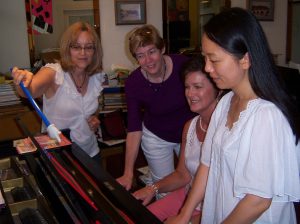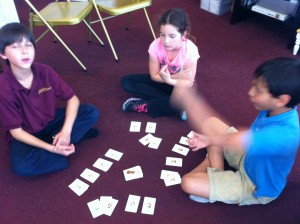Holiday Songs represent an evolving musical culture that spans 6 centuries and are the one body of songs that are more universal to our culture than anything else. Even though the harmonic treatments become more removed from the original with each passing year, there is still enough recognition of these songs even if they are now used to sell merchandise instead of their sacred original meaning.
The reinforcement students receive from family and friends by playing something “familiar”, as well as the short time span and goal of performance opportunities make students highly motivated to work on these songs.
However, in addition to the benefits to students mentioned above, these songs offer a treasure trove of opportunities to for discovering or reinforcing important basic music concepts that you are already teaching in other areas of your lessons. Don’t miss this golden opportunity for learning.
5-finger Patterns
Dreydl Song
Jingle Bells
Great for level 1 students. Have a spinner with 12 pentachord patterns on cards fanned around it. Students spin to transpose the song into the new key. To add extra zest, students give the jingle bells a shake after completing each scale.
Sequences
Have students discover the sequences in these songs.
Deck the Halls
We Wish You a Merry Christmas
O Christmas Tree
Angels We Have Heard on High
Ding Dong Merrily On High (one of the longest sequences I know)
Applying I and V7 chords
Use the formula, when the melody notes are 1, 3 and 5 use I chord, when on 2 and 4 use V7 to create a left hand for these melodies;
Dreydl Song
Jingle Bells
I IV V
Apply the same formula, adding the information that the 6th scale note goes with the IV chord.
Joy to the World
Silent Night (once the chords are established, apply broken chord style to bass for a simple but effective accompaniment pattern – if they are more advanced, they can apply ballad style (Root 5th 3rd above – use fingers 5 2 1)
Intervals
Look for the examples of these prominent intervals in these songs
Steps – The First Noel (the entire song is comprised of steps and fourths)
Skips –
4th and 5ths find the one fourth and one fifth, one skip, and the rest are repeated notes and steps
Octaves and major scales – Joy to the World
Major and Relative Minor Key Signatures
We 3 Kings
God Rest Ye Merry Gentlemen
Modes and Minor Keys
Use these songs to discover the difference between minor and dorian modes.
What Child is This
O Come O Come Emmanuel
Coventry Carol
Common Rhythm Patterns
Short Short Short Short Short Short LONG
Good King Wensceslas Looked Out
Jolly Old St. Nicholas
Compare to Twinkle Twinkle Little Star, Old MacDonald Had A Farm, Melody, by Schumann, Song by Kabalevsky., Haydn Surprise Symphony, and many others
Form – find songs that represent the following forms:
AABA (O Christmas Tree)
AABC (First Noel, Good King Wenceslas)
ABAB’(Jolly Old St. Nicholas, Jingle Bells)
Have students listen and guess which form that song follows.
Repeated Patterns
Students often are so focused on individual notes that they don’t notice broader patterns in the music. With your early level students, don’t make them learn all new notes of Jolly Old St. Nicholas for the second half when all they have to do is change the last note! This song is a great example of songs going “home” at the end, but ending on a dominant note “not home” in the middle.
The same applies to Jingle Bells – just learn the two differing parts of One Horse Open Sleigh first, then the rest of the song is mostly steps and repeated notes.
Acquiring Early Experience in Leading the Sing a Long
Help your students become valuable to their friends and community by getting them used to playing carols early; with the chording tools above they will realize they don’t always need to have music. Additionally they can transpose to singable keys (instead of C which is usually presented in early books because of ease of key signature)
Teach them how to use the last line of the song for a introduction, and to use body language (head nod) to start the group singing.
Teach them basic conducting patterns, by having students take turns, conducting, playing and singing.
Teach them how to work with other instrumentalists or vocalists by reading the chords of a fake book (or chords included in a song with traditional notation.) Many have friends who play guitar, etc.
Teach them a basic sing and strum method if the melody is provided by another instrument such as flute or vocals.
Jump in and have fun! Holidays only come around once a year!




![CompCrds_FB[small]](http://lakeshoremusicstudio.com/blog/wp-content/uploads/2013/07/CompCrds_FBsmall.jpg)
